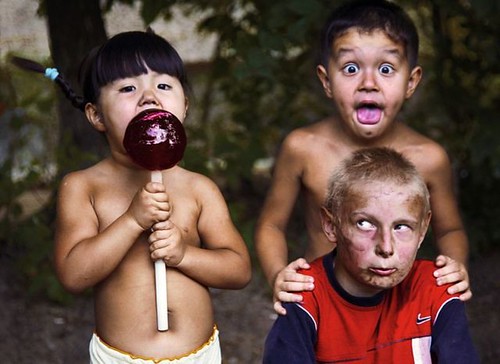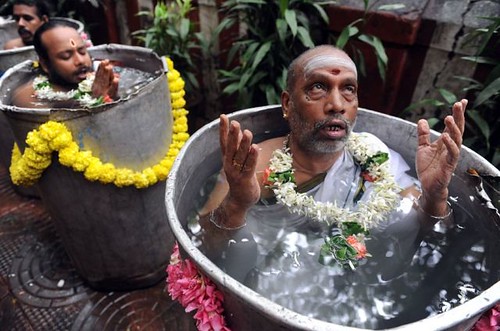The theory behind this is that the child through the use of such expressive opportunities will begin to display their internal conflicts or emotional distress. For instance with drawing the child can draw conflicts in the family or between its own internal ego states. This allows for the therapist to begin to understand what the child’s internal conflict and emotional state is like.
Some then hypothesise that as the child displays its angst through play that will allow it to express them and thus they will reduce. This is typical of the theory behind art therapy and some psychoanalytic perspectives. Alternatively those who follow more of the Carl Rogers approach see play as a means by which the child can express itself in the presence of a therapist. That therapist provides an environment that is safe, empathetic and unconditionally accepting of the child. It is the theorised that the child in such an environment will naturally begin to grow and develop towards health.

The woman whom I did my first two years of play therapy group training with was quite psychoanalytic in her perspective. The psychoanalytic, art therapy and Rogerian perspectives described above to me certainly hold merit. When running play therapy groups I use those approaches.
After I finished my training in play therapy I went out on my own and ran groups. Over time I noticed that they changed from the style of my original training. As I worked with children I found myself moving onto other techniques that seemed to have a result. This was not a cognitive process on my behalf but more of an intuitive process that just evolved over time

Three techniques that developed over time.
1. The approaches described above one could call quite passive approaches. The child is simply left to its own devices and would proceed and progress at its own pace with little direction from the therapist. That is indeed why Rogerian therapy is sometimes called non-directive therapy. Over time I found myself becoming more action oriented with the children which more suited my personality as a therapist. Instead of just letting a child express itself through drawing or clay I would be much more interactive in my questioning and comments with the child as he played. Asking what this and that was, requesting that they draw word bubbles for the people they were drawing, asking them to write what the various parts or people were thinking and feeling. Getting them to include pets and various other people and objects in the drawings or plasticine.
This allowed for more diagnosis and also I was getting the child to identify its internal conflicts and to basically do two chair. Offering them the opportunity to expressed the unexpressed feeling or thought or need.

2. Whilst the techniques being employed tended to be more action oriented so was the relational. The therapeutic relationship between the child and myself moved away from the passive “blank screen” therapist that one would find in the psychoanalytic and Rogerian approaches. When a child made some kind response to me directly I would seize upon it and use it to some therapeutic advantage.
For instance if an anxious child with a high Conforming Child ego state said or did something a bit rebellious to me I might highlight it and request that she do it again or some other derivative of it to me directly. Alternatively if there was another child in the group who expressed some defiance of me I might ask the conforming child to see if she could say the same thing to me. Once done she gets to experience the new behaviour and sees that my response back to her is not catastrophic or demeaning and so forth.
The relational contact between the child and the therapist became very interactive and goal oriented with myself manipulating it in various ways for various means. Over time this became a point of significant departure from how I was originally trained.
Again this was not a conscious goal of mine but it just evolved over time. As I became more adept and confident in working with children in the group therapy setting I think I just allowed my own natural personality to come out in that forum. This is certainly what I say to trainee therapists. Initially you begin as a technique based therapist. What you do with the client is based on what techniques you have learnt in your training. As one gets more confident then you the therapist as a person enters into your therapeutic style. One transforms from being a therapist named ‘Tony’ to being “Tony’ who happens to be a therapist. Hence the client will experience you as a person who also happens to be a therapist rather than the other way around.

3. Finally there was the development of romp play. By far the most common approach in play therapy with children is as I described before. A low key, meditative, self explorative type of approach. Over time I developed this thing called romp play which is a far more cathartic approach. It is high energy, boisterous, jumping, rough and tumble, very interactional type of play. From what I have seen of the literature this is quite unusual. Whilst some other approaches do have some cathartic methods they are nothing like the romp play described here.
Originally it evolved as a method for children to develop their own internal Parent ego state controls. It is structured such that the group proceeds with - romp play on, romp play off, romp play on, romp play off and so forth.
Romp play is high energy Free Child behaviour. Whilst that is all good and well the problem with high Free Child is people can end up getting hurt physically and emotionally. Unrestrained Free Child can be dangerous. One needs to develop a Parent ego state that can control it when necessary. In the group any child could put a stop to the romp play at any time by using a prearranged word and all the romp play would stop. Those children who found it hard to stop would be stopped by the therapist. This allowed the children to begin incorporating this into their own Parent ego state. They learnt how to be Free Child and how to contain it when necessary. They were learning the internal controls to do that by their own Parent ego state.

However I think there is more to romp play than just this, although it is hard for me to articulate what that actually is. I could just recite the theory and say that the Free Child is that natural part in all of us and thus when expressed we are being our natural selves in this way. One can assume that when such expression is achieved this will be therapeutic in itself. This is probably all true but there is something that nags in the back of my mind about this. There is something more to this romp type of play for children that I feel the theory is yet to enunciate. When children have an opportunity to do a very free type of play and relating there is some kind of therapeutic effect on them that I cannot yet describe.
Graffiti
They enliven each other and themselves. Its lovely and its the difference between adults (grown ups) who do and adults(grown ups) who don't. We learn to understand ourselves by meeting the other.
ReplyDeleteWell, only guessing about that realy. A lady told me something she read just the other night. She said that when someone is welcomed (genuinely that is) and their company is actually appreciated and enjoyed, that it does something chemically to us. We change.
I truely love your style and ohhh! Tony! When you said:
"One transforms from being a therapist named ‘Tony’ to being “Tony’ who happens to be in a therapist. Hence the client will experience you as a person who also happens to be a therapist rather than the other way around."
I hugged you so bigly! Because going through this transition yourself (knowingly), well, that's the transition that your clients go through too. With you (as they begin to see the person of you) but also with themselves (as they begin to see the person of themselves).
There's a difference between imagining (or visulising) walking on the beach or beside a tree lined river bank and actually experiencing the real thing.
Such a beautiful post Tony! Beautiful! ((((Tony))))
Hello Roses,
ReplyDeleteNo arguement from me about the positive psychological impact on us when we see others like us and enjoy us.
Glad you liked the post Roses and it is hard to be yourself first and a therapist second as we are trained to not be that. So one in essence has to discard this aspect of their training
Graffiti
So why is it in our training then? I don't understand.
ReplyDeleteThis comment has been removed by a blog administrator.
ReplyDelete